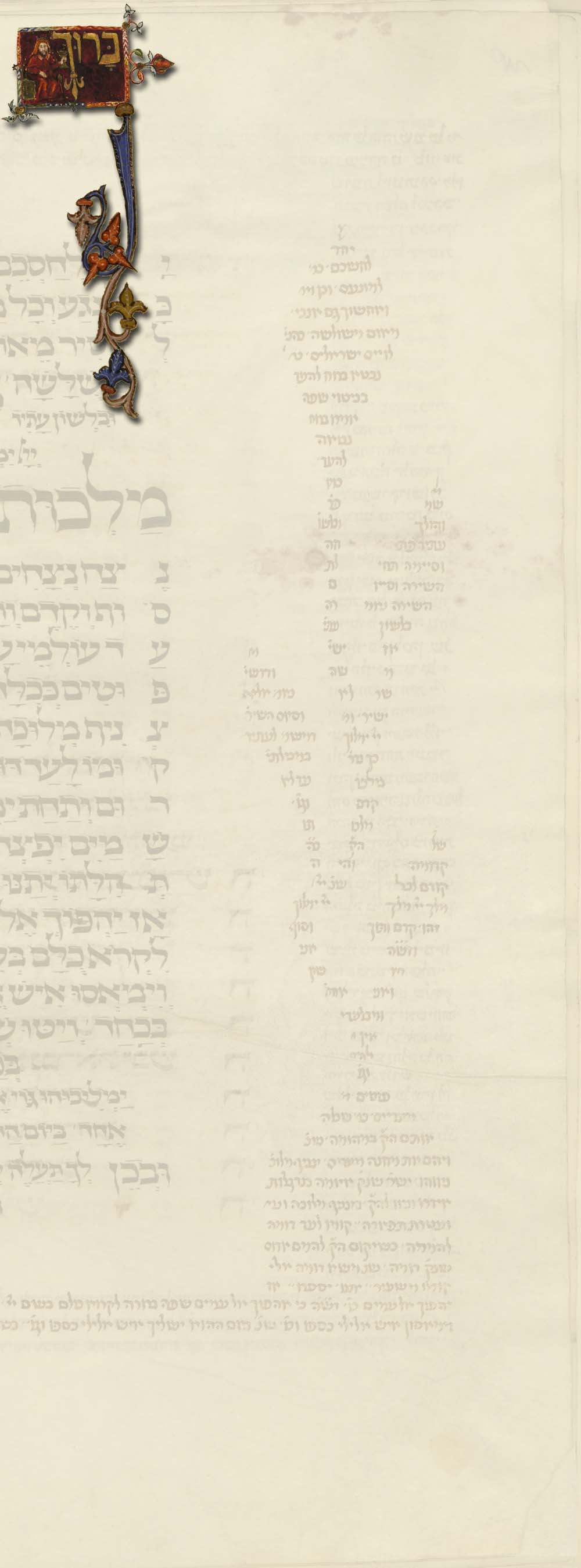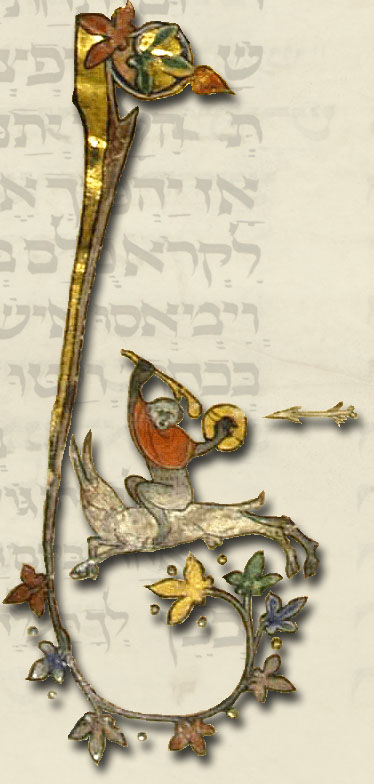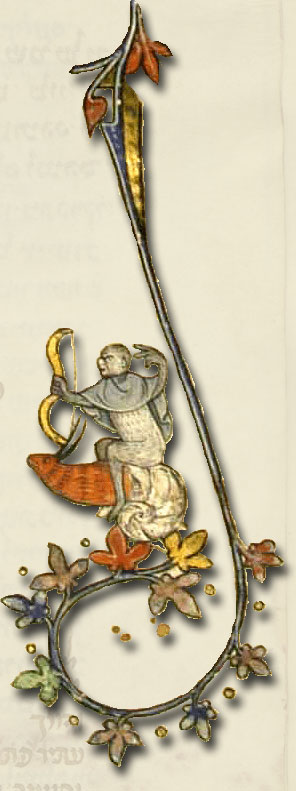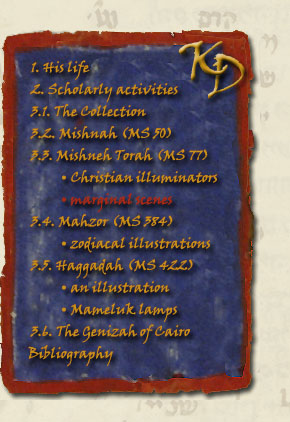




Another remarkable trait of this
manuscript is that it contains many profane illustrations in the margin – in one
instance the illustration is even obscene – which bear no relation whatsoever to
the text. 128
This cannot be regarded a unique feature of manuscripts produced in the middle
of the 13th century: their emergence was closely connected to the spread of
Dominican and Franciscan preaching at the time with parables and exempla using
motifs from animal fables, bestiaries 129
and 130
– sometimes even becoming completely independent of the text itself. 131
The widespread use of anecdotes in sermons was meant to rekindle flagging
interest in theological dogma among believers, and the margin illustrations
![]() in
manuscripts are to a considerable extent visual manifestations of themes
popularized through fabliaux and exempla. 132
Gabrielle Sed-Rajna has shown that
most of “the marginal figures have been transferred to this manuscript from a
model book used also for several contemporary Latin manuscripts from the same
area, executed for the local aristocratic family
Bar” – an example of close professional relationship between
craftsmen of the Jewish and Christian communities. 133
The popularity of representations of this kind in Christian art in general is
attested, for instance, by the fiery diatribe of Bernard of
Clairvaux (1090-1153) against
non-religious monastic ornamentation. 134
It may be remarked that margin illustrations – including obscene representations
– abound in Christian liturgical books while they are rare in secular ones,
in
manuscripts are to a considerable extent visual manifestations of themes
popularized through fabliaux and exempla. 132
Gabrielle Sed-Rajna has shown that
most of “the marginal figures have been transferred to this manuscript from a
model book used also for several contemporary Latin manuscripts from the same
area, executed for the local aristocratic family
Bar” – an example of close professional relationship between
craftsmen of the Jewish and Christian communities. 133
The popularity of representations of this kind in Christian art in general is
attested, for instance, by the fiery diatribe of Bernard of
Clairvaux (1090-1153) against
non-religious monastic ornamentation. 134
It may be remarked that margin illustrations – including obscene representations
– abound in Christian liturgical books while they are rare in secular ones,
 a
strange phenomenon, which Randall
is inclined to attribute to an attempt at “provocation by contrast.” 135
Not infrequently it is difficult to decipher the exact symbolic meaning of a
given illustration; sometimes this is hardly any longer possible in view of the
frequent occurrence of more or less abstruse references to contemporary persons
and ideas. There can be no doubt, however, that these margin illustrations were
often simply the figments of the artists' imaginations, “diversions which
relieved the tedium of daily life.” 136
Thus for instance at the bottom of
folio 46 of volume I of our manuscript, the
frontispiece of the Book of Adoration, we can see a scene “from the
Roman de Renard: the fox, having stolen a goose (or here a cock), is pursued
by a woman brandishing a spindle.” 137
In connection with the obscene scene in the upper margin – a man shooting an
arrow at the nude hindquarters of a man bending forward – one cannot help but
imagine the illuminator who, tired of his monotonous work, suddenly conceives a
prank just like an adolescent, in the same way as his modern-day successor, the
composer of entries in an encyclopaedia, tired of carding, inserts an entry on a
non-existent painter into the serious work of reference, or the lexicographer
suddenly gives vent to the accumulated tension of monotony in one of his
entries. 138
a
strange phenomenon, which Randall
is inclined to attribute to an attempt at “provocation by contrast.” 135
Not infrequently it is difficult to decipher the exact symbolic meaning of a
given illustration; sometimes this is hardly any longer possible in view of the
frequent occurrence of more or less abstruse references to contemporary persons
and ideas. There can be no doubt, however, that these margin illustrations were
often simply the figments of the artists' imaginations, “diversions which
relieved the tedium of daily life.” 136
Thus for instance at the bottom of
folio 46 of volume I of our manuscript, the
frontispiece of the Book of Adoration, we can see a scene “from the
Roman de Renard: the fox, having stolen a goose (or here a cock), is pursued
by a woman brandishing a spindle.” 137
In connection with the obscene scene in the upper margin – a man shooting an
arrow at the nude hindquarters of a man bending forward – one cannot help but
imagine the illuminator who, tired of his monotonous work, suddenly conceives a
prank just like an adolescent, in the same way as his modern-day successor, the
composer of entries in an encyclopaedia, tired of carding, inserts an entry on a
non-existent painter into the serious work of reference, or the lexicographer
suddenly gives vent to the accumulated tension of monotony in one of his
entries. 138
 This overtly homosexual scene, which has numerous counterparts in contemporary
Franco-Flemish religious manuscripts, 139
appears to be a late testimony of a considerable period of social tolerance
which saw the efflorescence and prosperity of various urban minority groups in
Western Europe, but mostly in France, during the period of urban revival in the
High Middle Ages, which had its climax between 1050 and 1150, and disappeared
immediately after the thirteenth century. 140
It was in this stiffening social atmosphere, too, in the course of events
accompanying the waning of social tolerance in general, that Jews were expelled
from France in 1306, and our manuscript, copied and illuminated in France a few
years earlier, was in all probability taken to Cologne by one of the fugitive
families. 141
This overtly homosexual scene, which has numerous counterparts in contemporary
Franco-Flemish religious manuscripts, 139
appears to be a late testimony of a considerable period of social tolerance
which saw the efflorescence and prosperity of various urban minority groups in
Western Europe, but mostly in France, during the period of urban revival in the
High Middle Ages, which had its climax between 1050 and 1150, and disappeared
immediately after the thirteenth century. 140
It was in this stiffening social atmosphere, too, in the course of events
accompanying the waning of social tolerance in general, that Jews were expelled
from France in 1306, and our manuscript, copied and illuminated in France a few
years earlier, was in all probability taken to Cologne by one of the fugitive
families. 141
It was not a rare phenomenon for a
manuscript to be illuminated with inappropriate scenes: this was a field where

![]() contemporary illuminators and copyists were able to display their abilities
“indulging in the feeling of freedom with wild leaps and caprices.” 142
Thus in a contemporary manuscript in the Ambrosiana in Milan we come across
animals such as cocks, apes and dogs decorating philosophical works, and it can
only have been the spread and popularity of such inappropriate animal figures
that made Rabbi Yehudah
ben
Samuel the Pious of Speyer in
Germany deem it necessary in the second half of the 12th century to prescribe
that upon the employment of Jewish Bible-copyists it should be made a condition
that they abstain from executing the massoretic apparatus in the shape of all
sorts of animals and birds, as happened for instance in the famous Bible
manuscript in the Karlsruhe County Library, which had once belonged to Johann
Reuchlin, where one initially has
the impression of seeing a whole menagerie of lions, bears, oxen, sheep and
other animals only to
realize later,
after thorough examination, that all these
animals are in fact concealing the massoretic apparatus written in an extremely
small microscript. 143
contemporary illuminators and copyists were able to display their abilities
“indulging in the feeling of freedom with wild leaps and caprices.” 142
Thus in a contemporary manuscript in the Ambrosiana in Milan we come across
animals such as cocks, apes and dogs decorating philosophical works, and it can
only have been the spread and popularity of such inappropriate animal figures
that made Rabbi Yehudah
ben
Samuel the Pious of Speyer in
Germany deem it necessary in the second half of the 12th century to prescribe
that upon the employment of Jewish Bible-copyists it should be made a condition
that they abstain from executing the massoretic apparatus in the shape of all
sorts of animals and birds, as happened for instance in the famous Bible
manuscript in the Karlsruhe County Library, which had once belonged to Johann
Reuchlin, where one initially has
the impression of seeing a whole menagerie of lions, bears, oxen, sheep and
other animals only to
realize later,
after thorough examination, that all these
animals are in fact concealing the massoretic apparatus written in an extremely
small microscript. 143
Similar representations of animals can be seen in one of the manuscripts of Malmad ha-talmidim, the philosophical sermons by Jacob ben Abbamare (Jacob Anatole), one of the followers of Maimonides, a translator at the court of the Holy Roman Emperor Frederick II. One of the pages (f.4v) of this manuscript (shelf-mark: MS Kaufmann A 287) written in Rimini in Italy towards the end of the 14th century is decorated with splendid illustrations both in the margins and the central parts of the page, crowned by the representation of a lion and lioness lying under stylized trees – the illustration is drawn to life and very nearly radiates the Renaissance joie de vivre. 144
![]() There is another illuminated
two-volume copy of the Mishneh Torah in the Kaufmann Collection of
considerable weight, which was written in 1310 in Germany (MS Kaufmann A 78).
Its artistic qualities, however, fall far behind those of the previous one. In
the miniature which ornaments the frontispiece of the Book of Knowledge there is
a lion sitting on the top of a dome flanked by two turrets while the bearded,
seated figure of Maimonides wearing
a pointed hat appears below the central arch. In the upper title
compartment four dogs are hunting a stag, watched by a seated rabbit. In the
lower compartment, from left to right, we see a man about to hit a quadruped
with an axe, a stork, and Samson and the lion, while on the left an owl is
watching a bear (?) lick honey from a jar. 145
There is another illuminated
two-volume copy of the Mishneh Torah in the Kaufmann Collection of
considerable weight, which was written in 1310 in Germany (MS Kaufmann A 78).
Its artistic qualities, however, fall far behind those of the previous one. In
the miniature which ornaments the frontispiece of the Book of Knowledge there is
a lion sitting on the top of a dome flanked by two turrets while the bearded,
seated figure of Maimonides wearing
a pointed hat appears below the central arch. In the upper title
compartment four dogs are hunting a stag, watched by a seated rabbit. In the
lower compartment, from left to right, we see a man about to hit a quadruped
with an axe, a stork, and Samson and the lion, while on the left an owl is
watching a bear (?) lick honey from a jar. 145
128 See Gabrielle
Sed-Rajna’s contribution
The visual dimension of Jewish civilisation. Concepts and realisations
in the present volume.
129
Sed-Rajna 1984. 35.
130 See Gustave
Lanson: Histoire de la
littérature française. Onzičme édition revue. Paris 1909. 103-109.
131
Sed-Rajna 1984. 35. See
also Joseph Gutmann:
Hebrew manuscript painting. New York 1978. 84.
132 Lilian M. C.
Randall: Images in the
margins of Gothic manuscripts. Berkeley – Los Angeles 1966. 8. Cf.
Id.: Exempla as a source
of Gothic marginal illumination. In: Art Bulletin 39 (1957) 97-107.
133 Gabrielle
Sed-Rajna: The
illustrations of the Kaufmann Mishneh Torah. In: Journal of Jewish
Art 6 (1979). See also her contribution to the present volume The
visual dimension of Jewish civilisation. Concepts and realisations.
134 Quoted in
Randall 1966. 31.
135
Randall 1966. 14.
136 Ibid., 18.
137
Sed-Rajna 1984. Plate V. On
the Roman de Renard, see
Lanson 1909. 93-103.
Kindlers Literatur Lexikon. Zürich 1965. VI. 450-455.
Laffont-Bompiani: Dictionnaire des oeuvres. Paris
1952-1954. IV. 305-309.
138 Művészeti lexikon.
[=Encyclopaedia of art].
Edited by Anna Zádor and
István Genthon. Budapest. 1965-1968. III. 37 [s.v. Alfred
Leanque]. (This
ingenious, playful entry deals with a non-existent French painter, whose
name reminds a Hungarian reader of the adjective “link” meaning
“unserious”, “useless” in colloquial Hungarian.) Előd
Halász: Német-magyar szótár [=German-Hungarian
dictionary]. 9th ed. Budapest
1988. I. 1035 [s.v. Igel]. (Under this entry, as the equivalent
of a familiar German expression, a long obscene quotation reminiscent of
a Hungarian folk-song appears.) Or, from a different viewpoint, this
illustration can perhaps be regarded as a parallel to the graffiti
termed “scatological” by Littmann;
Enno Littmann: Thamūd
und Safā. Studien zur altnordarabischen Inschriftenkunde.
[Abhandlungen für die Kunde des Morgenlandes, XXV, 1.] Leipzig 1940.
77-78.
139 See, e.g.,
Randall 1966. Plates CIV.
fig. 502 [Merman and man, shot by], CX-CXII. figs. 533-538, CXII. fig.
539 [shooting hindquarters], fig. 540 [do.], fig. 541 [spear
aimed at hindquarters], fig. 542 [trumpet aimed at hindquarters]. Cf.
also the lengthy list Randall
1966. 192-194 [Obscaena].
Cf. also Lexikon der christlichen Ikonographie 1968-1976. III.
337-338.
140 John
Boswell: Christianity,
social tolerance and homosexuality. Chicago–London 1981. 209-301,
333-334.
141
Sed-Rajna 1984. 37.
Kaufmann 1898. 257.
Similarly inappropriate figures appear in medieval church architecture
as well; see, e.g., Peter
Spranger: Heilig-Kreuz-Münster Schwäbisch Gmünd.
Schwäbisch Gmünd 2000. 22.
143
Kaufmann 1898. 257-258,
303. On this see Thérčse Metzger:
La masora ornementale et le décor calligraphique dans les manuscrits
hébreux espagnols au Moyen Age. Colloques Internationaux de Centre
National de la Recherche Scientifique. No 547: La
paléographie hébraďque médiévale. Paris 11-13 septembre 1972. 87-116,
Pl. XCVII-CXII. Joseph Gutmann:
Masorah figurata: The origins and development of a Jewish art
form. In: Estudios masoreticos (V Congreso de la IOMS)
dedicados a Harry M. Orlinsky. Editados por Emilia Fernández Tejero.
Madrid 1983. 49-62. [Reprinted in: Gutmann
1989. XV. 49-62].
144
Kaufmann 1898. 290-291.
Weisz 1906. 99-100.
145
Kaufmann 1898. 284-285.
Narkiss – Sed-Rajna 1988.
Second Kaufmann Mishneh Torah. Card Nos 4-6.
